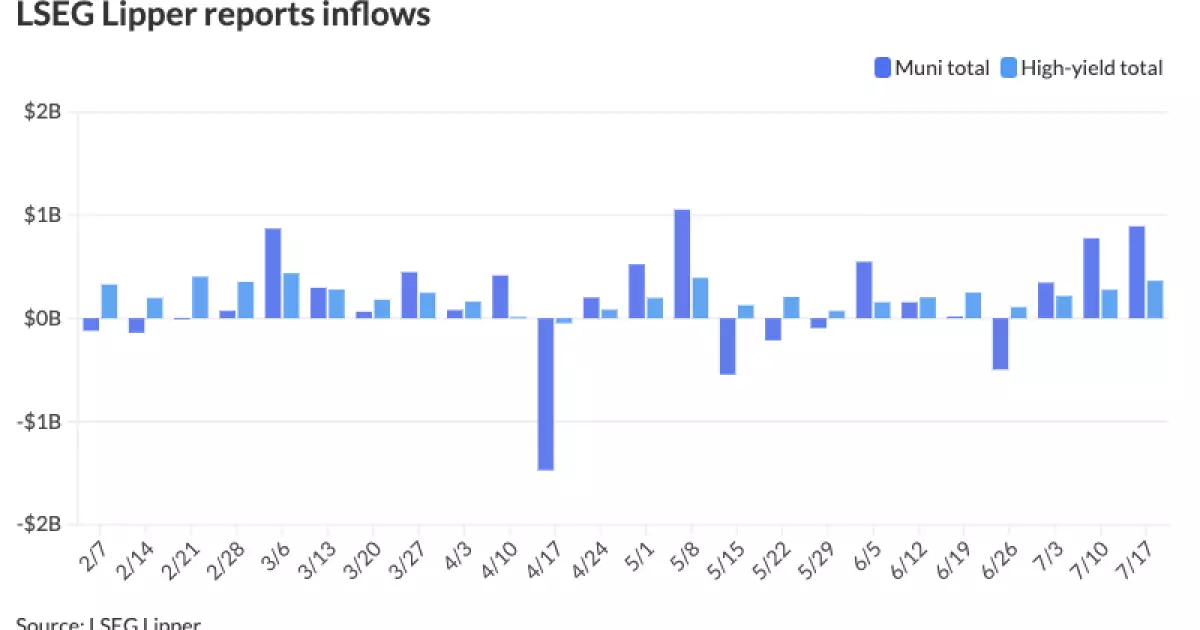The municipal bond market has recently showcased a slight strengthening, particularly in short-term offerings, amid varying dynamics from external markets and investor behavior. Observations from Thursday indicate that municipal mutual funds received a buoyant influx of capital, amounting to approximately $891.4 million—an increase from the prior week’s inflow of $775.3 million. This trend signifies a renewed interest among investors, likely driven by the attractive relative yields that municipal bonds currently offer, especially in comparison to Treasury securities and equities. As we proceed through this period of heightened activity, it’s important to dissect the contributing factors and potential implications for market participants.
While municipal bonds display a degree of resilience, the broader landscape suggests caution. U.S. Treasury yields have risen concurrently, exerting pressure on risk assets such as equities, which faced notable sell-offs. This dichotomy sets the stage for the ongoing evaluation of municipal bonds against Treasury performance. The comparative ratios on Thursday for various maturities revealed a steady 64% for two-year munis against U.S. Treasuries, with ratios similarly positioned for three- to ten-year bonds. This consistent trend suggests a tightening of spread between munis and Treasuries as investors weigh risk and reward carefully.
Strategists from GW&K Investment Management posited an optimistic outlook for municipal bonds amidst evolving economic conditions. Despite concerns about a slowing economy, fundamentals underpinning municipal credit remain robust. This resilience is enhanced by conservative budgeting practices and record-high reserves, providing a solid foundation even in the face of external volatility. The influx of investments, particularly evident in the high-yield space where inflows reached $364.4 million, further exemplifies the attractiveness of these assets as reliable income sources.
There is also a historical precedence for positive performance within the municipal sector during the summer months. Analysts highlighted the typically favorable conditions characterized by high reinvestment flows coupled with diminished issuance, presenting a scenario conducive to robust returns. According to industry insights, although some of the performance benefits may have been front-loaded into June, several indicators point toward sustained strength in the municipal bond markets, driven by attractive yields and a seasonal uptick in demand and supply dynamics.
The influx of capital into the municipal markets has been met with significant levels of issuance, particularly from high-quality offerings slated for 2024. Morgan Stanley noted the sizeable transactions, including a noteworthy pricing for the San Francisco Public Utilities Commission’s wastewater revenue bonds. The $624.615 million issuance reflects a competitive environment where investors are favoring sustainable projects—a trend echoed across various other municipalities engaged in eco-conscious financing.
Recent issuance dynamics suggest that despite a slowdown in primary market activity after a vigorous couple of days, the pipeline remains active. Major entities, including the Texas Transportation Commission and New York City, prepare for substantial bond issuances that could cumulatively amount to billions over the coming weeks. Such sustained liquidity indicates persistent investor interest and supports the observable flatness in market indices as they absorb the influx of securities without altering their performance significantly.
As market participants navigate this complex landscape, attention to risk management strategies becomes paramount. Investment professionals like Craig Brandon from Morgan Stanley note that while the high-quality segment is buoyed by substantial issuance, there exists a supply-demand imbalance particularly pronounced in the high-yield market. This could lead to unique opportunities for thoughtful investors willing to take on moderate risks.
With the Federal Reserve’s policy decisions looming on the horizon, analysts anticipate that money will eventually shift from money market funds into riskier assets—potentially revitalizing demand in the municipal bond arena. Furthermore, GW&K highlights an awareness of potential volatility tied to external events, such as the upcoming November elections, which could introduce unpredictable market movements.
The municipal bond market stands at an intriguing intersection of optimism and caution as it grapples with external economic pressures while demonstrating underlying strength. With solid credit fundamentals and the allure of attractive yields, investors must stay attentive to shifting dynamics and potential opportunities that will arise in the coming months. As the landscape evolves, those able to navigate these waters adeptly will likely find substantial prospects for growth and income within the municipal space. Personal financial strategies should reflect a nuanced understanding of these market trends to capitalize on the unique environment presented by municipal bonds.

